Dryas octopetala is a very common and beautiful plant of alpine slopes in this area, and in addition, it has the delightful habit of repeated bloom through the season.
It can also be grown fairly easily in the garden here (last photo)... why I bother with my relatively feeble effort, though, when I see them in natural splendour throughout our mountain hikes, I don't know! ??? Anyway, it is another point in its favour, as if it needed one!

Comments
Todd Boland
Re: Dryas octopetala
Sun, 02/21/2010 - 3:49pmI don't grow this one...mainly because it would take up too much room in the rockery! I do have our native D. integrifolia which is at least slower growing.
Sellars (not verified)
Re: Dryas octopetala
Mon, 02/22/2010 - 7:47pmLori:
We have the same issue with Dryas octopetala. It does not perform as well in our garden as in the mountains though some years are better than others with lots more flowers. One of its endearing characteristics is that it roots easily from cuttings. One day I will bring home a good specimen from the mountains and see if it does better than the garden variety.
Trond Hoy
Re: Dryas octopetala
Wed, 03/10/2010 - 1:25pmD. octopetala (reinrose = rose of reindeer) is the only dryas in Norway (in the mountains on calcareous soil) but in the gardens it is the hybrid D x suendermannii which is commonly grown (I have this one). Have tried the real thing but it is not as easy as the hybrid but the flowers of octopetala is better.
Trond Hoy
Re: Dryas octopetala
Fri, 07/30/2010 - 12:49amDryas octopetala commonly grows on exposed south-facing sites where the snow retreats early in the season. Later the flowering is more sporadic.
Todd Boland
Re: Dryas octopetala
Mon, 08/02/2010 - 4:05amI have the hybrid as well. Drays drummondii is very rare in Newfoundland but D. integrifolia is quite common in limestone regions. It is a smaller-sized version of D. octopetala.
Lori S. (not verified)
Re: Dryas octopetala
Mon, 08/08/2011 - 12:39pmAnd speaking of repeated bloom through the season...
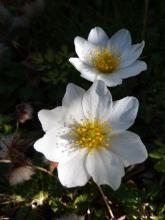
From the garden:
Lori S. (not verified)
Re: Dryas octopetala
Sat, 11/10/2012 - 10:23amWild scenes with Dryas octopetala... ubiquitous and beautiful!
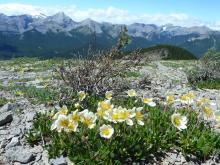
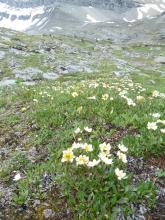
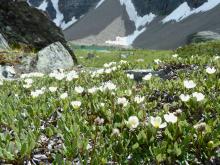
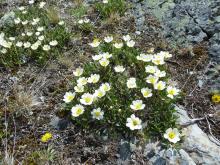
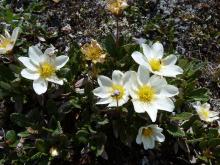
(I wonder if the first photo may actually be a hybrid with D. integrifolia?)
In the garden - an easy one to grow here:
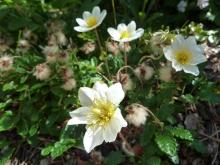
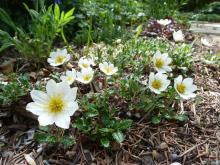
cohan (not verified)
Re: Dryas octopetala
Sat, 11/10/2012 - 4:58pmGreat plants and views, Lori! I see no reason to not grow beloved natives in the garden- they can be seen more often and closely than in the wild!
Todd, we also have D integrifolia; at the Columbia Icefields, I have see integrifolia, octopetala and drummondii all growing together, I don't know if they cross..
Richard T. Rodich
Re: Dryas octopetala
Sat, 11/10/2012 - 5:24pmI don't think my flowers ever get that big. Quite easy to grow here in Minnesota, too,
although it is also easily crowded out by taller growing plants.
Trond Hoy
Re: Dryas octopetala
Sun, 11/11/2012 - 2:51amBeautiful, Lori! Both the plants and the landscape ;)
Although this species is rather common in the mountains here I have never tried wild collected specimens in the garden neither from seed. I have a plant of garden origin at my cabin though (probably D x sundermannii, a cross between D. drummondii and octopetala) as it never sets seed.
D. octopetala is an early bloomer so I rarely do see it in flower where I usually walk but last summer I was at Finse where the snow lingers till August or longer. But no pictures with both Dryas and view!
Margaret Young
Re: Dryas octopetala
Sun, 11/11/2012 - 7:21amWonderful photos of this iconic plant for all SRGC members .....
your pictures show why it makes such a popular logo for us!
[attach=1]
;D
cohan (not verified)
Re: Dryas octopetala
Mon, 11/12/2012 - 11:03amA few views from the area near the foot of the Athabasca Glacier, on the Icefileds Parkway in Alberta. There are large areas of Dryas here- octopetala and drummondii- integrifolia as well, I think, though in some I am not sure whether they are clear species or crosses; This was one of the few times (only?) I was there at the right time to catch these in flower- this from June 26, 2010.
Looking more closely now, I see some of the leaves slightly recurved- is this normal variation for octopetala, or could it suggest crossing with integrifolia? If anyone feels any of these are integrifolia, let me know and I'll move them ;) I've saved some pics that seem more clearly to be integrifolia for the new topic I started for that species..
Richard T. Rodich
Re: Dryas octopetala
Mon, 11/12/2012 - 5:16pmLori's quote from Flora of Alberta reads that D. octopetala has "somewhat revolute" leaf margins. So I would think that questioning its species status would not be a concern.
Is it common to have such multi-petaled flowers? Really pretty - enough to make them stand out and enhance their beauty without taking too much away from simplicity, yet not enough to scream out man made hybrid.
cohan (not verified)
Re: Dryas octopetala
Mon, 11/12/2012 - 11:01pmRick, I mostly questioned the species since other plants looking more or less like integrifolia could be growing right beside these more octopetala types.. no doubt some of them must be hybrids :)
I don't have wide enough experience to know how common the multipetalled flowers are.. they didn't strike me at the time as being unusual, just part of a variably flowered population (of a couple of species and hybrids...lol)..
Trond Hoy
Re: Dryas octopetala
Tue, 11/13/2012 - 8:34amI can't say whether they're hybrids or not but the mulipetalled form is highly uncommon - in fact I have never seen any with much more than 8! So probably they are hybrids?
The form of the petals differ, however, as shown here: (Dryas octopetala)
cohan (not verified)
Re: Dryas octopetala
Tue, 11/13/2012 - 10:29amI think at the time I took those photos I wasn't even thinking about the two species and the possibility of hybrids, so I didn't take the kind of photographs that would highlight the important characters - maybe another time!
Here's another shot from a different site- very different kind of habitat! Lower in elevation, below the treeline though still not by a lot; This plant is in a wooded area, on nearly bare rock next to a stream/waterfall.. It's just behind a popular roadside stop where you can look back on the highway where it has just climbed up/down from the river valley below to near the treeline... We stopped there this year at the end of May, and this shaded area still had some deep snow banks...
John P. Weiser
Re: Dryas octopetala
Tue, 11/13/2012 - 12:06pmI can keep D. octopetala alive and spreading in Reno as long as it gets watered regularly. It seems to take the heat pretty well in that the year old leaves shrivel and dry while the new leaves stay nice. I never get many flowers however maybe four or five on a one foot square mat.
Do you think that I don't get cold enough in the winter to set buds?
Trond Hoy
Re: Dryas octopetala
Tue, 11/13/2012 - 12:20pmI have grown it (or maybe it was the cross x sundermannii) at home where it flowered every spring and my winters are not cold. I have also seen beautiful colonies at the sea level in southern Norway (in northern Norway all kind of alpines grow down to sea level). The plants in south don't get too much cold (they are relicts from the last glaciation and are far from the mountains).
cohan (not verified)
Re: Dryas octopetala
Tue, 11/13/2012 - 11:46pmCan't help with that, John- I haven't grown it yet myself, and of course when I do, it won't have any problem with lack of cold!
I do also wonder, though, if there is simply variability in number of flowers per plant? Some of those I photographed had quite a few flowers, others not so many.. I haven't seen enough of them in different places in flower to really know, though...